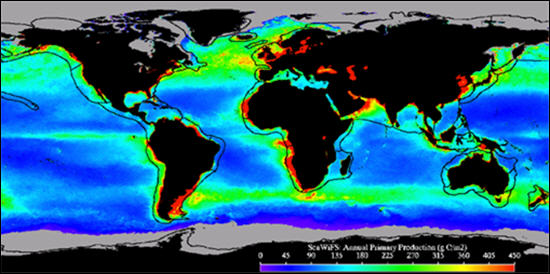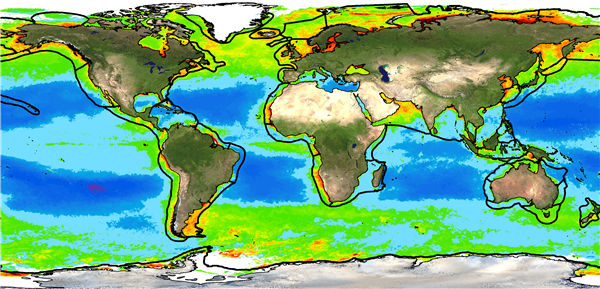Introduction to the LME Portal: The Large Marine Ecosystem Approach to the Assessment and Management of Coastal Ocean Waters
Large Marine Ecosystems (LMEs) are relatively large areas of ocean space of approximately 200,000 km² or greater, adjacent to the continents in coastal waters where primary productivity is generally higher than in open ocean areas.

Global map of average primary productivity and the boundaries of the 64 Large Marine Ecosystems (LMEs) of the world, available at www.lme.noaa.gov. The annual productivity estimates are based on Sea WiFS satellite data collected between September 1998 and August 1999, and the model developed by M. Behrenfeld and P.G. Falkowski (Limnol. Oceangr. 42(1): 1997, 1-20). The color-enhanced image provided by Rutgers University depicts a shaded gradient of primary productivity from a high of 450 gCm-2yr-1 to a low of 10gCm-2y-1.
Chlorophyll Animation Methods
Time Series Animations have been developed showing temporal fluxuations of chlorophyll within individual LMEs
Phytoplankton chlorophyll time-series animations (movies) were constructed for 62 large marine ecosystems (LMEs) for the 15-year period from September 1997 to June 2012 using NASA ocean color satellite data from the Sea-viewing Wide Field-of-view Sensor (SeaWiFS) and Moderate Resolution Imaging Spectrometer (MODIS-Aqua) sensor. These sensors carried on satellites in daily orbit have provided comprehensive coverage of the world's oceans (McClain, 2004). Ocean color is a key indicator of chlorophyll, phytoplankton abundance and biomass and provides important data about conditions at the base of the oceans' food chain.

